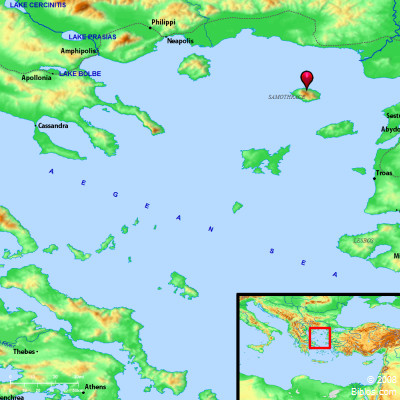Encyclopedia
SAMOTHRACEsam'-o-thras (Samothrake, "the Thracian Samos"; the King James Version Samothracia, sam-o-thra'sha; the island was formerly Dardania; for change of name see Pausanias vii.4, 3; Strabo x.457, and for a full discussion Conze, Hauser and Benndorf, Neue Untersuchungen auf South, 1880): An island in the Aegean Sea, South of Thrace opposite the mouth of the Hebrus River, and Northwest of Troas. The island is mountainous, as the name indicates (see SAMOS), and towers above Imbros when viewed from the Trojan coast. The summit is about a mile high. It is mentioned in the Iliad (xiii.12) as the seat of Poseidon and referred to by Virgil Aeneid vii0.208.
The island was always famous for sanctity, and the seat of a cult of the Cabeiri, which Herodotus (ii.51) says was derived from the Pelasgian inhabitants (see also Aristophanes, Pax 277). The mysteries connected with the worship of these gods later rivaled the famous mysteries of Eleusis, and both Philip of Macedon and Olympias his wife were initiated here (Plut. Alex. 3).
Probably because of its sacred character the island did not figure to any extent in history, but in the expedition of Xerxes in 480 B.C., one ship at least of the Samothracian contingent is mentioned as conspicuous in the battle of Salamis.
The famous "Victory of Samothrace" (now in the Louvre) was set up here by Demetrius Poliorcetes circa 300 B.C., and was discovered in 1863. Since that time (1873-75), the Austrian government carried on extensive excavations (see Conze, Hauser and Benndorf, op. cit.).
In the New Testament the island is mentioned in Acts 16:11. From Troas, Paul made a straight run to Samothrace, and the next day sailed to NEAPOLIS (which see) on the Thracian coast, the port of PHILIPPI (which see). At the northern end of Samothrace was a town where the ship could anchor for the night, and on the return journey (Acts 20:6) a landing may have been made, but no details are given. Pliny characterizes the island as being most difficult for anchorage, but because of the hazards of sailing by night, the ancient navigators always anchored somewhere if possible.
LITERATURE.
See under SAMOS.
Arthur J. Kinsella
SAMOTHRACIA, an island on the n.e. coast of the AEgean Sea, 23 ms. from the main land, 14 ms. long, 7 1/2 ms. wide, its central mountain peak is 5245 ft. above the sea. Now called Samothraki, area 30 sq. ms. pop. 1500.
Strong's Greek
G4543: Samothrak"Samos of Thrace," Samothrace, an island in the Aegean




